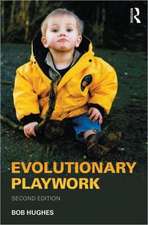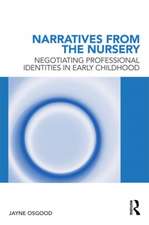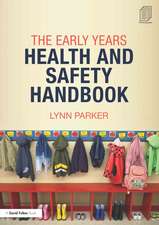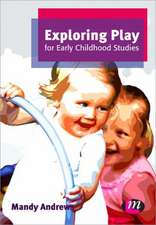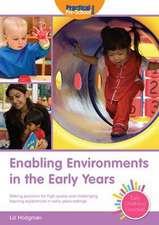Building the Reading Brain, PreK-3
Editat de Pamela A. Nevills, Patricia A. Wolfeen Limba Engleză Paperback – 16 feb 2009
Preț: 285.50 lei
Nou
Puncte Express: 428
Preț estimativ în valută:
54.63€ • 57.30$ • 45.48£
54.63€ • 57.30$ • 45.48£
Carte tipărită la comandă
Livrare economică 01-15 aprilie
Preluare comenzi: 021 569.72.76
Specificații
ISBN-13: 9781412963268
ISBN-10: 1412963265
Pagini: 232
Dimensiuni: 178 x 254 x 19 mm
Greutate: 0.48 kg
Ediția:Second Edition
Editura: SAGE Publications
Colecția Corwin
Locul publicării:Thousand Oaks, United States
ISBN-10: 1412963265
Pagini: 232
Dimensiuni: 178 x 254 x 19 mm
Greutate: 0.48 kg
Ediția:Second Edition
Editura: SAGE Publications
Colecția Corwin
Locul publicării:Thousand Oaks, United States
Recenzii
"An absolute must-read, must-understand, and must-do for all primary teachers and principals. Nevills and Wolfe's book addresses the difficult issues of diagnosis and intervention with early readers before they begin to struggle.”
"A unique resource that provides a biological foundation for effective reading strategies. It is a valuable resource for any educator."
"The research information is powerful for educators to interpret for practical, everyday use and can be supplemented with current reading curriculum.”
“I devoured this book! The book makes research come alive and accessible whether you are new to literacy work or have been immersed in it for years!”
“Besides providing comprehensible information on neuroscience and learning, the book gives many excellent strategies and ideas for working with a variety of readers from emergent literacy through third grade. I highly recommend this book for all educators at all age levels.”
“This is an amazing resource for all persons interested in improving their instructional practice or understanding of how the young child’s brain is wired for reading, and how tapping into strategic reading practices will promote comprehension, fluency, and reading enjoyment. The authors make the most current research in neuroscience and reading engaging and interesting. This well-constructed book is one of my favorites!”
"A unique resource that provides a biological foundation for effective reading strategies. It is a valuable resource for any educator."
"The research information is powerful for educators to interpret for practical, everyday use and can be supplemented with current reading curriculum.”
“I devoured this book! The book makes research come alive and accessible whether you are new to literacy work or have been immersed in it for years!”
“Besides providing comprehensible information on neuroscience and learning, the book gives many excellent strategies and ideas for working with a variety of readers from emergent literacy through third grade. I highly recommend this book for all educators at all age levels.”
“This is an amazing resource for all persons interested in improving their instructional practice or understanding of how the young child’s brain is wired for reading, and how tapping into strategic reading practices will promote comprehension, fluency, and reading enjoyment. The authors make the most current research in neuroscience and reading engaging and interesting. This well-constructed book is one of my favorites!”
Cuprins
Acknowledgments
About the Authors
Introduction
1. On the Nature of Reading
The Importance of Learning to Read
Why Learning to Read Is So Difficult
The Basics of Reading
Reflective Questions
2. What Happens in the Brain When Children Read Words?
Brain Basics
Reading Problems With a Biological Basis
Attention and Memory Systems
Reflective Questions
3. Building a Foundation for Reading: Birth to Age 3
Reading Relies on Early Language Skills
The Beginnings of Language
The Language Explosion: 1 to 2 Years
Precursors to Writing in the First 3 Years
Reflective Questions
4. Emerging Literacy During the Preschool Years
Mirror Neurons Drive Learning
Oral Language and Vocabulary
Print Awareness and Alphabet
Developing Writing Skills
Reflective Questions
5. Beginning to Read: Ages 5 and 6
Instruction Essentials for Emerging Readers
The Brain's Memory Systems
Breaking Away From Static Teaching Tradition
Priming Skills for 5- and 6-Year-Olds
Reflective Questions
6. Breaking the Reading Code: Learning to Read Through Instruction
Reading and Language Arts Guidelines for Kindergarten and First Grade
Structuring the Brain for Decoding
Word Recognition Gains Sophistication
Teaching Encoding: Spelling and Writing
Reading Beyond Encoding and Decoding
Reflective Questions
7. Assessing and Responding to Readers at Risk
The Case for Early Assessment
English Language Learners
Assessments of Students With Regularly Developing Reading Skills
Differences in Brain Development
Assessment and Reading Standards
Response to Intervention: Reading Models
School Interventions That Work
Reflective Questions
8. Comprehension and Vocabulary: Challenges for Second Grade
Reading and Language Arts Guidelines for Second Grade
Instruction for Vocabulary and Comprehension
Ways to Teach the Curious Brain
Building the Brain for Comprehension
Strategic Reading With Comprehension in Mind
Reflective Questions
9. Putting Reading Skills to the Task: Expectations for Third Grade and Beyond
Reading and Language Arts Guidelines for Third Grade
Factors Affecting Reading Fluency
The Brain's Rate of Processing
Developing Reading Fluency
Final Comments
Reflective Questions
10. Conclusion
A Child's Brain and Reading: A Dozen Key Learnings
Glossary
Instructional Resources
References and Further Reading
Index
About the Authors
Introduction
1. On the Nature of Reading
The Importance of Learning to Read
Why Learning to Read Is So Difficult
The Basics of Reading
Reflective Questions
2. What Happens in the Brain When Children Read Words?
Brain Basics
Reading Problems With a Biological Basis
Attention and Memory Systems
Reflective Questions
3. Building a Foundation for Reading: Birth to Age 3
Reading Relies on Early Language Skills
The Beginnings of Language
The Language Explosion: 1 to 2 Years
Precursors to Writing in the First 3 Years
Reflective Questions
4. Emerging Literacy During the Preschool Years
Mirror Neurons Drive Learning
Oral Language and Vocabulary
Print Awareness and Alphabet
Developing Writing Skills
Reflective Questions
5. Beginning to Read: Ages 5 and 6
Instruction Essentials for Emerging Readers
The Brain's Memory Systems
Breaking Away From Static Teaching Tradition
Priming Skills for 5- and 6-Year-Olds
Reflective Questions
6. Breaking the Reading Code: Learning to Read Through Instruction
Reading and Language Arts Guidelines for Kindergarten and First Grade
Structuring the Brain for Decoding
Word Recognition Gains Sophistication
Teaching Encoding: Spelling and Writing
Reading Beyond Encoding and Decoding
Reflective Questions
7. Assessing and Responding to Readers at Risk
The Case for Early Assessment
English Language Learners
Assessments of Students With Regularly Developing Reading Skills
Differences in Brain Development
Assessment and Reading Standards
Response to Intervention: Reading Models
School Interventions That Work
Reflective Questions
8. Comprehension and Vocabulary: Challenges for Second Grade
Reading and Language Arts Guidelines for Second Grade
Instruction for Vocabulary and Comprehension
Ways to Teach the Curious Brain
Building the Brain for Comprehension
Strategic Reading With Comprehension in Mind
Reflective Questions
9. Putting Reading Skills to the Task: Expectations for Third Grade and Beyond
Reading and Language Arts Guidelines for Third Grade
Factors Affecting Reading Fluency
The Brain's Rate of Processing
Developing Reading Fluency
Final Comments
Reflective Questions
10. Conclusion
A Child's Brain and Reading: A Dozen Key Learnings
Glossary
Instructional Resources
References and Further Reading
Index
Descriere
The second edition of this bestselling book examines the development of the young brain, paying specific attention to the acquisition and development of language as preparation for reading.


